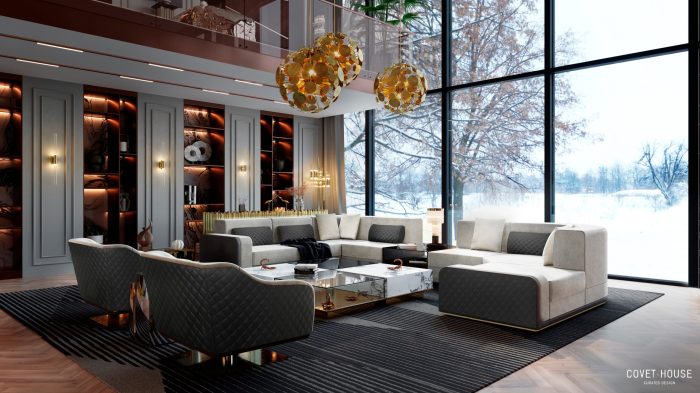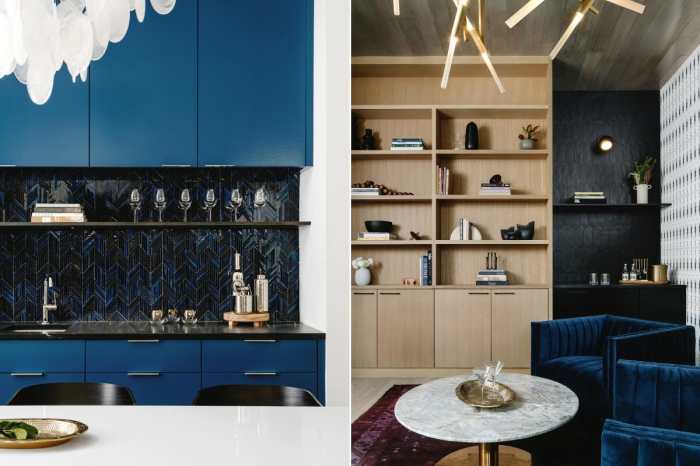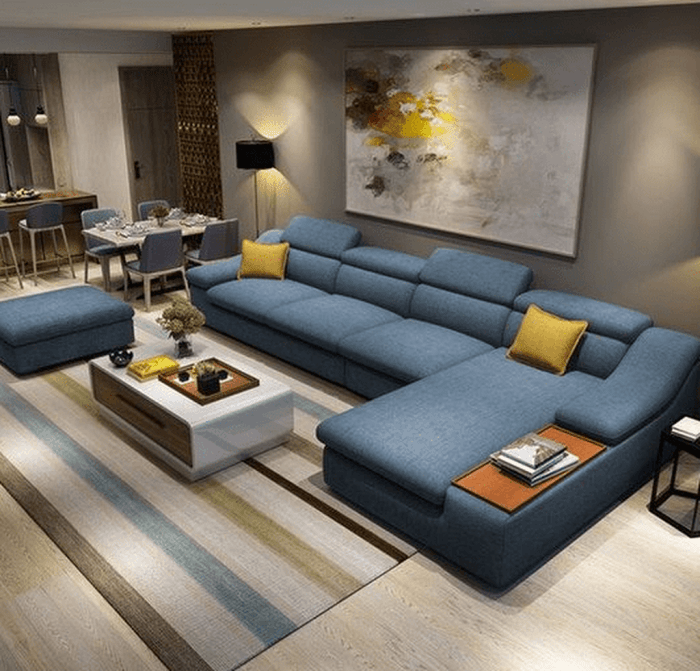Defining “High-End” Home Decor

High end home decor – High-end home decor transcends mere aesthetics; it’s an investment in quality, craftsmanship, and enduring style. It’s about creating a space that reflects not only personal taste but also a commitment to superior materials and meticulous detail. This segment will delve into the defining characteristics of high-end home decor, comparing it to other market segments and exploring the diverse stylistic expressions it encompasses.
Defining “high-end” is inherently subjective, influenced by individual preferences and market fluctuations. However, several key factors consistently distinguish high-end pieces from their mid-range and budget-friendly counterparts. These include the quality of materials used, the sophistication of the manufacturing techniques employed, the complexity and originality of the design, and the established reputation of the brand or designer. Price, while a significant indicator, is ultimately a reflection of these underlying qualities.
High-End Home Decor Compared to Other Market Segments
The table below highlights the key differentiators between high-end, mid-range, and budget-friendly home decor options. Understanding these differences allows consumers to make informed decisions aligned with their budget and aesthetic goals.
| Feature | High-End | Mid-Range | Budget-Friendly |
|---|---|---|---|
| Material Quality | Premium materials like solid wood, hand-woven textiles, genuine leather, and ethically sourced stones. | Combination of premium and less expensive materials; potentially some synthetic elements. | Primarily synthetic materials, mass-produced woods, and less durable fabrics. |
| Manufacturing Techniques | Handcrafted, intricate detailing, specialized techniques (e.g., hand-carving, bespoke tailoring). | Mixture of machine and hand-crafted elements; some level of automation. | Primarily mass-produced using automated machinery; limited hand-finishing. |
| Design Complexity | Intricate designs, unique details, often one-of-a-kind or limited-edition pieces. | Well-designed, but less intricate; more readily available designs. | Simple designs, often mass-produced with minimal unique features. |
| Brand Reputation | Established designers, heritage brands, known for quality and exclusivity. | Reputable brands with a focus on value and style. | Often lesser-known brands or mass-market retailers. |
Styles Associated with High-End Home Decor
High-end home decor encompasses a broad spectrum of styles, each characterized by its unique aesthetic and approach to design. The selection of a particular style reflects personal preference and the desired ambiance within a space.
For instance, minimalist high-end decor prioritizes clean lines, functionality, and a limited color palette. Think of a meticulously crafted, solid wood coffee table paired with a single, statement piece of modern sculpture. In contrast, maximalist design embraces richness and abundance, layering textures, patterns, and colors to create a vibrant and eclectic atmosphere. Imagine a luxurious velvet sofa adorned with ornate cushions, surrounded by richly colored artwork and antique accessories.
Traditional styles evoke a sense of classic elegance and timeless sophistication, often featuring antique or antique-inspired furniture, ornate details, and rich fabrics. A beautifully carved mahogany dining table surrounded by plush velvet chairs exemplifies this style. Modern high-end decor emphasizes sleek lines, innovative materials, and a focus on functionality. A minimalist steel and glass dining table with integrated lighting would be a fitting example.
Finally, eclectic high-end decor masterfully blends elements from various styles and eras, creating a unique and personalized space. This might involve pairing a mid-century modern armchair with a vintage Persian rug and a contemporary sculpture.
Pricing and Market Analysis

The high price point of high-end home decor is a reflection of its inherent value proposition: superior quality, craftsmanship, and exclusivity. Understanding the pricing structure requires examining the multifaceted factors contributing to the overall cost. This analysis will explore these factors and provide a market overview of this exclusive segment.
Factors Contributing to High Costs
Several key elements drive the high cost of luxury home decor. First, premium materials are fundamental. Think sustainably sourced hardwoods, hand-woven textiles from renowned artisans, and ethically-sourced gemstones used in embellishments. These materials are inherently more expensive due to their rarity, sustainability certifications, and the labor involved in their sourcing and processing. Secondly, the craftsmanship involved is often unparalleled.
Highly skilled artisans, many working with traditional techniques passed down through generations, dedicate considerable time and expertise to each piece. This meticulous attention to detail, coupled with the specialized skills required, significantly increases the cost. Thirdly, the design element itself commands a premium. Renowned designers, architects, and interior decorators contribute significantly to the value proposition. Their expertise, reputation, and the intellectual property embedded in their designs justify higher prices.
Furthermore, established brands benefit from substantial brand recognition and the associated prestige. Consumers are often willing to pay a premium for the assurance of quality, heritage, and exclusivity that established brands represent. Finally, exclusivity plays a significant role. Limited edition pieces, bespoke creations, and items with restricted availability command higher prices due to their rarity and desirability.
Price Ranges of High-End Home Decor Items
The price ranges for high-end home decor vary considerably depending on the item, materials, brand, and design complexity. The following table provides a general overview of price ranges, acknowledging that significant variations exist within each category:
| Item Category | Price Range (USD) | Example |
|---|---|---|
| Furniture (Sofa) | $5,000 – $50,000+ | A bespoke, hand-crafted sofa from a renowned Italian furniture maker using premium leather and intricate detailing. |
| Lighting (Chandelier) | $2,000 – $100,000+ | A crystal chandelier featuring hand-cut Swarovski crystals and intricate metalwork, designed by a celebrated lighting designer. |
| Textiles (Rug) | $1,000 – $50,000+ | A hand-knotted silk rug from Nepal, featuring intricate patterns and using high-quality, ethically-sourced silk. |
| Artwork (Painting) | $10,000 – $Millions | An original painting by a renowned contemporary artist, or a limited edition print from a master artist. |
The Typical High-End Home Decor Customer
The typical high-end home decor customer is discerning and values quality, craftsmanship, and exclusivity above all else. They are often high-net-worth individuals with established careers and a sophisticated lifestyle. Demographics typically include older millennials and Gen X, though affluent younger individuals are increasingly entering this market. Their purchasing habits are characterized by a willingness to invest in durable, high-quality items that reflect their personal style and enhance their lifestyle.
They are often well-informed about design trends and seek unique, one-of-a-kind pieces that set their homes apart. They prioritize personalized service and appreciate the expertise of interior designers and other professionals in curating their spaces. Brand reputation and provenance are significant factors influencing their purchasing decisions. These customers often engage in long-term relationships with their preferred designers and brands, demonstrating loyalty and repeat business.
Sustainability and Ethical Considerations
The rising demand for eco-conscious luxury is reshaping the high-end home decor market. Consumers are increasingly prioritizing brands that align with their values, demanding transparency and accountability throughout the supply chain. This shift necessitates a deeper understanding of sustainable materials, ethical labor practices, and the long-term environmental impact of design choices. High-end brands are responding by integrating sustainable practices, not merely as a marketing tactic, but as a core element of their brand identity and a crucial factor in long-term success.Consumers are actively seeking out high-end pieces that reflect their commitment to environmental and social responsibility.
This involves scrutinizing the materials used, the manufacturing processes employed, and the brand’s overall commitment to ethical sourcing and production. Transparency and traceability are paramount, allowing consumers to make informed decisions that align with their values. The integration of sustainable practices is no longer a niche aspect but a critical component for establishing credibility and attracting discerning customers in the luxury market.
High-end home decor transcends mere aesthetics; it’s a reflection of the inner sanctuary you cultivate. The heart of the home, the kitchen, deserves equally exquisite attention. Elevate its spiritual essence with thoughtfully chosen wall art, perhaps exploring the vast selection of stunning pieces available at kitchen decor wall art , to create a space that nurtures and inspires.
This thoughtful touch completes the holistic journey of creating a truly high-end living environment.
Eco-Friendly Materials in High-End Home Decor, High end home decor
The use of sustainable materials is a cornerstone of eco-conscious high-end home decor. This includes sourcing wood from responsibly managed forests, utilizing recycled or reclaimed materials, and incorporating plant-based alternatives to traditional materials. For example, companies are increasingly using reclaimed wood from demolished buildings, giving it a unique character while reducing deforestation. Bamboo, a rapidly renewable resource, is another popular choice for furniture and flooring, offering both durability and sustainability.
Similarly, the use of organic cotton and linen in textiles reduces the environmental impact compared to conventionally grown materials. These choices not only minimize environmental harm but also often enhance the aesthetic appeal of the final product, adding a layer of unique texture and story to each piece.
Ethical Manufacturing Practices in High-End Home Decor
Ethical manufacturing encompasses fair labor practices, safe working conditions, and the responsible treatment of workers throughout the production process. High-end brands are increasingly prioritizing transparency and traceability in their supply chains, ensuring that their products are made ethically and responsibly. This includes conducting regular audits of their factories to ensure compliance with labor standards, paying fair wages, and providing safe working environments.
For example, some luxury brands partner with organizations dedicated to fair trade, guaranteeing fair wages and safe working conditions for artisans and craftspeople. This commitment not only benefits the workers but also enhances the brand’s reputation and strengthens its relationship with consumers who value ethical sourcing.
Examples of High-End Brands Incorporating Sustainable Practices
Several high-end home decor brands are leading the way in incorporating sustainable practices. For instance, a leading Scandinavian furniture company uses sustainably sourced wood and recycled materials in its furniture production, emphasizing minimalist design to reduce material waste. Their commitment extends to their packaging, using recycled and biodegradable materials. Another example is a luxury textile brand that uses organic cotton and employs local artisans, supporting local economies while reducing the carbon footprint associated with long-distance transportation.
These brands demonstrate that luxury and sustainability are not mutually exclusive; rather, they can be complementary aspects of a successful and responsible business model. Their success showcases the growing consumer demand for ethically and sustainably produced luxury goods.
Illustrative Examples

High-end home decor transcends mere aesthetics; it’s an experience crafted from meticulous detail, luxurious materials, and a cohesive design vision. The following examples showcase the artistry and precision involved in creating truly exceptional living, bedroom, and dining spaces.
High-End Living Room Setting
This expansive living room, measuring approximately 25′ x 30′, embodies sophisticated modern elegance. The color palette centers on warm neutrals – a creamy off-white on the walls, complemented by the deep brown tones of a richly stained oak hardwood floor. A large, custom-designed sectional sofa in a plush, light grey velvet anchors the space. The sofa’s clean lines are echoed in a low-profile coffee table crafted from polished concrete and accented with brushed brass detailing.
Two statement armchairs, upholstered in a luxurious textured linen in a complementary taupe shade, flank a bespoke marble fireplace mantel, its surface veined with subtle grey and white streaks. Subtle ambient lighting is provided by recessed ceiling lights and strategically placed floor lamps with linen shades, while a dramatic crystal chandelier serves as a focal point above the coffee table.
Large windows allow ample natural light, enhancing the airy feel of the room. Artwork, including a large abstract painting and several carefully curated sculptures, completes the sophisticated look.
High-End Bedroom Setting
This serene master suite, approximately 20′ x 18′, is a sanctuary of calm and understated luxury. The walls are painted in a soft, calming shade of celadon green, creating a tranquil atmosphere. The flooring is composed of wide-plank, light oak, subtly stained to maintain its natural warmth. A king-size bed, with a custom-made headboard upholstered in a luxurious silk velvet in a deep teal color, dominates the space.
The bedding is crisp, white Egyptian cotton, layered with a cashmere throw. Two matching bedside tables, crafted from reclaimed wood with polished brass hardware, flank the bed, each topped with a sleek table lamp with a linen shade. A large, custom-designed walk-in closet, seamlessly integrated into the room’s design, is accessed through a hidden door, maintaining the clean, uncluttered aesthetic.
The overall feel is one of quiet elegance, achieved through the careful selection of textures and the subtle interplay of color.
High-End Dining Room Setting
This formal dining room, measuring approximately 18′ x 15′, exudes timeless sophistication. The walls are adorned with a textured, hand-painted silk wallpaper in a subtle damask pattern, in muted shades of grey and gold. The flooring is polished dark walnut, creating a rich and elegant base. A large, handcrafted mahogany dining table, seating eight to ten comfortably, takes center stage.
The table is paired with intricately carved chairs upholstered in a luxurious leather, in a deep burgundy shade. A stunning crystal chandelier, cascading from the high ceiling, casts a warm, inviting glow over the space. A custom-designed sideboard, crafted from the same mahogany as the dining table, provides ample storage and display space. The room’s aesthetic is completed with carefully chosen accessories, including a selection of fine china, silverware, and crystal glassware, displayed on the sideboard and within a glass-fronted cabinet.
The overall impression is one of refined luxury and understated elegance.
Clarifying Questions: High End Home Decor
What is the average lifespan of high-end furniture?
With proper care, high-end furniture, particularly pieces crafted from solid wood and quality materials, can last for generations, far exceeding the lifespan of mass-produced alternatives.
How do I identify authentic high-end pieces?
Look for hallmarks of quality: superior materials, impeccable craftsmanship (hand-finishing, intricate details), reputable brand names, and a clear provenance. Be wary of suspiciously low prices.
Can I mix high-end and mid-range pieces?
Absolutely. A well-curated mix can create a unique and sophisticated look. Focus on maintaining a cohesive color palette and design style.
How much should I budget for high-end home decor?
Budgeting depends on the scope of your project and your desired level of luxury. It’s advisable to consult with designers and get detailed quotes to accurately assess costs.
